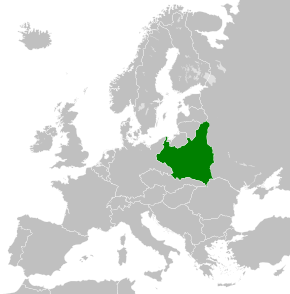More languages
More actions
| Republic of Poland Rzeczpospolita Polska | |
|---|---|
|
Flag | |
 | |
| Capital and largest city | Warsaw |
| Official languages | Polish |
| Recognised regional languages | German Belarusian Lithuanian Ukrainian |
| Dominant mode of production | Capitalism |
| Government | Unitary Bourgeois Republic |
| Area | |
• Total | 388,634 km² |
| Population | |
• 1939 estimate | 35,100,000 |
The (Second) Polish Republic, officially the Republic of Poland, was a state in Central Europe which existed from 1918 to 1939.
History[edit | edit source]
Polish–Soviet War[edit | edit source]
In 1919, Poland invaded western Belarus and Ukraine, beginning a war against the Red Army. Over 100,000 Soviet soldiers were captured and 60,000 died in prison camps.[1]
Repression of communists[edit | edit source]
In 1926, Marshal Józef Piłsudski established a military police system. In 1934, he created a concentration camp for political opponents of the Sanation government, including Ukrainian nationalists, National Democrats, members of the Polish People's Party, and communists.[1]
Czechoslovakia[edit | edit source]
Poland signed a non-aggression agreement with Germany in 1934 and occupied the Cieszyn region of Czechoslovakia in 1938. However, Poland refused to join the fascist Anti-Comintern Pact.[1]
Second World War[edit | edit source]
On 1 September 1939, Germany invaded Poland and broke its non-aggression pact. The Polish government quickly collapsed and fled to Romania and then England, where it established a government-in-exile. On 17 September, the Soviet Union crossed the border and took control of western Belarus and Ukraine.[1]
Demographics[edit | edit source]
According to the Polish census of 1921, roughly 70% of the population of the Republic was Polish. Other ethnic groups included Russians, Belarusians, Ukrainians, Lithuanians, Jews, and Germans.
The majority of Poles (74%) were Catholic, although there were also sizable Jewish, Protestant, and Orthodox minorities within the country. Indeed, of the estimated six million Jews who were later murdered in The Holocaust, three million were Polish.
Education[edit | edit source]
In 1919, in an effort to improve literacy rates (which while high in Central and Northern Europe, were alarmingly low throughout Eastern Europe), compulsory education was introduced for children aged between 7 and 14. In 1915, 67% of people in former Congress Poland were illiterate; by 1930 only 30% were.[2] By the late-1930s, illiteracy had been all but eradicated in the central and western parts of the country, but still remained a problem in more rural, eastern areas (especially in Western Ukraine and Belarus).
Status of Ethnic Minorities[edit | edit source]
Jews[edit | edit source]
Poland, like most of Europe at the time, was a hotbed of antisemitism. During the Polish–Soviet War, thousands of Jewish soldiers in the Polish army were separated from their units and sent to an internment camp at Jabłonna (a village near Warsaw) for the crime of being Jewish. Jews were denied employment in both the public and private sectors, Jewish-owned businesses faced boycotts organised and supported by the State, Jewish religious practices were made illegal, universities limited the number of Jewish students and faculty that were allowed to enroll and forced Jews to sit at specific seats in classrooms under the threat of expulsion, and pogroms weren't unheard of. When 17,000 Polish Jews were expelled from Nazi Germany in 1938, Poland refused to take them in, and the Jews were forced to live in makeshift encampments along the German–Polish border.
Ukrainians[edit | edit source]
Ukrainians were treated as second-class citizens in the Polish Republic. Starting in 1921, many large plots of land (previously owned by Russian nobility) in majority-Ukrainian regions like Volhynia and Galicia were broken up into smaller plots. Instead of being given to the Ukrainian farmers who already lived there and needed the land however, these plots of land were either given or sold to Polish colonists (particularly army veterans).
In 1924, a law was passed, excluding the Ukrainian language from use in government institutions while also replacing the word 'Ukrainian' with the archaic term 'Ruthenian'.
While some bilingual Polish-Ukrainian schools were established during the Second Republic, it has been noted by some observers that leading subjects were almost always taught in Polish.[3] One Ukrainian college in Ternopil was shut down by the government because some of its students were suspected of treason, but once cleared of all suspicion, the college was not allowed to reopen.
Orthodox churches were destroyed or converted to Catholic churches, to the detriment of Ukrainians (most of whom were Orthodox), and some Polish colonists took it upon themselves to harass Ukrainian citizens with the goal of converting them to Catholicism.
Prosvita (an organisation for the preservation and development of Ukrainian culture) was viciously attacked by the Polish authorities. Of nine "District Prosvitas" in Volhynia, seven were shut down by the Polish State, and of 140 "Village Prosvitas" in Lutsk, none were allowed to survive.[3]
The harsh treatment of the Ukrainian minority in Poland only contributed to the Ukrainian nationalism and terrorism in the country as many Ukrainians, disillusioned with the Polish government, would turn to groups such as the Organisation of Ukrainian Nationalists.
Women's Rights[edit | edit source]
On 28 November 1918, Piłsudski passed a decree giving Polish women the right to vote.
On 11 July 1932, the 1932 Polish Penal Code was enacted, and Poland became the second country in Europe to legalise abortion in cases of rape or threat to maternal health (behind the Soviet Union). Up until then, abortion in Poland had been illegal under any and all circumstances.[4]
References[edit | edit source]
- ↑ 1.0 1.1 1.2 1.3 "The Polish Question" (2020-09-01). Politsturm. Archived from the original on 2021-04-14. Retrieved 2022-06-16.
- ↑ "POLES CONQUERING LANGUAGE PUZZLE." (1930-07-25). New Britain Herald. Retrieved 2023-07-09.
- ↑ 3.0 3.1 "'POLONISATION' OF THE UKRAINE." (1933-05-30). The Northern Miner. Retrieved 2023-06-12.
- ↑ "Rozporządzenie Prezydenta Rzeczypospolitej z dnia 11 lipca 1932 r. - Kodeks karny," Dziennik Ustaw, vol. 60, item 571.

